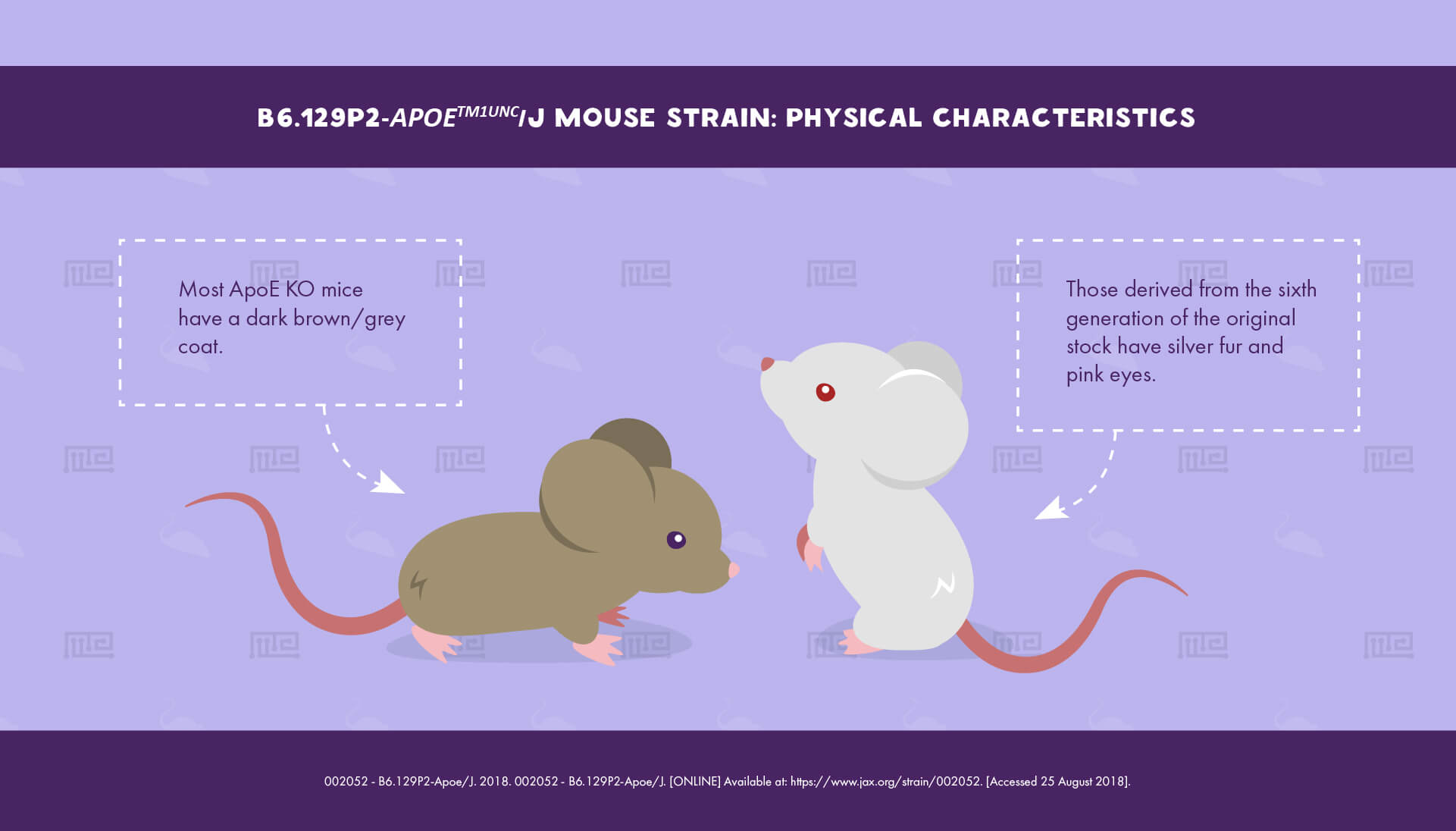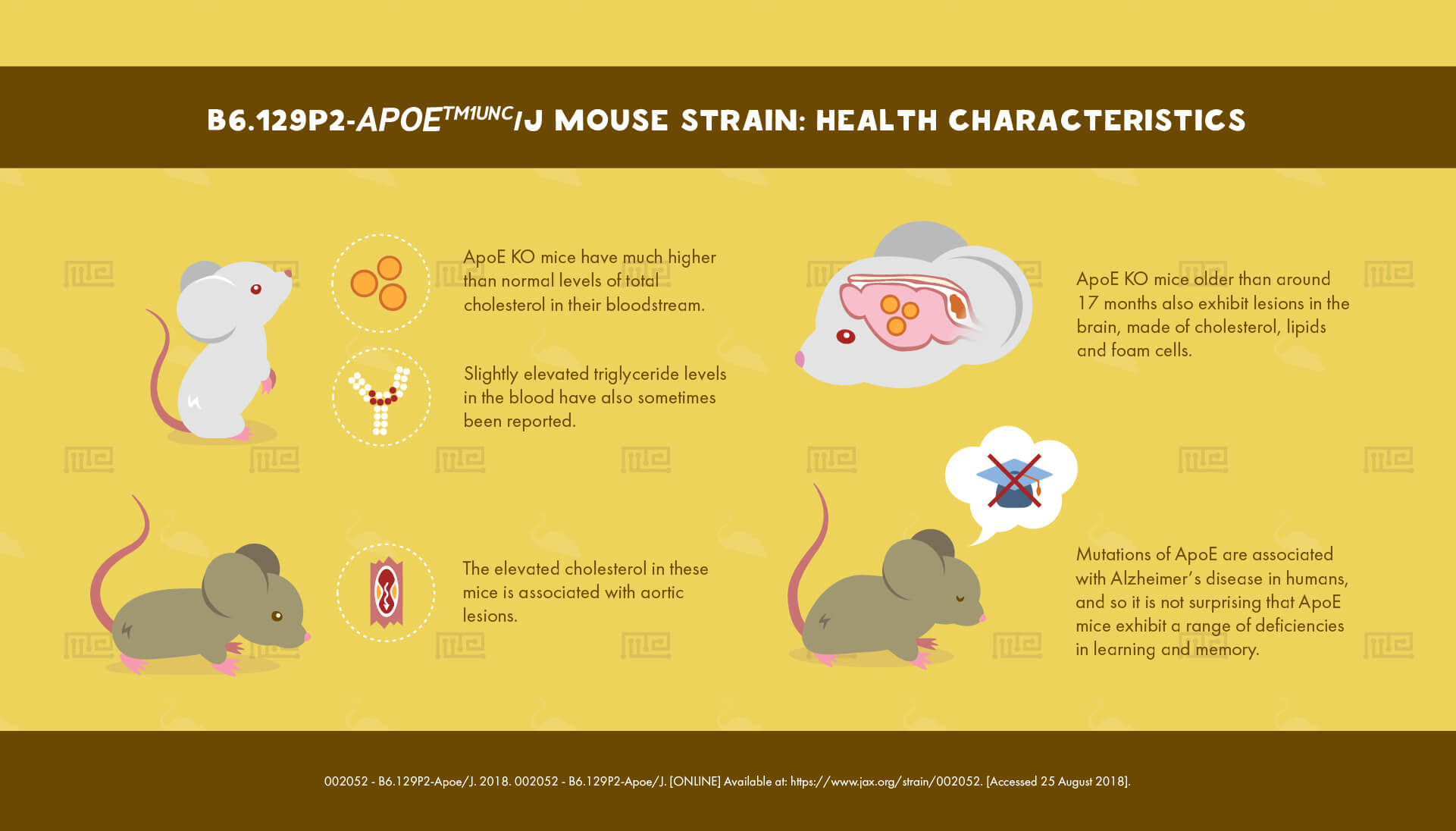Overview
B6.129P2-Apoetm1Unc/J, also known as ApoE KO, is an inbred strain of mouse model that is most noted for possessing a mutation of the important lipoprotein ApoE.[1]
History
This strain was created artificially through genetic engineering at the University of North Carolina. Dr. Nobuyo Maeda inserted the mutant ApoE gene using a plasmid known as pNMC109 and then backcrossed the mutation ten times in C57BL/6J mice. The current strain is thus a mutant form of C57BL/6J.[1]
Physical Characteristics
Most ApoE KO mice have a dark brown/grey coat, although those derived from the sixth generation of the original stock have silver fur and pink eyes.[1]
Behavioral Characteristics & Handling
As a result of cholesterol-linked brain lesions and synaptic loss (see below), ApoE KO mice display deficits in spatial learning and memory,[1] although evidence for this is controversial. Two studies[2][3] report poor performance by this strain in the Morris water maze, but researchers caution[2] that they only perform badly in the “procedural component” of this test, and not in spatial learning and memory per se.
Qualms over jumping to conclusions about this strain’s cognitive deficits are further substantiated by reports that these mice perform better than controls (wild type C57BL/6J mice) in the radial arm maze.[3] They do however show clear abnormalities in working memory, in which they have shown deficiencies in both the Y maze and novel object recognition test.[4]
In addition to these aberrations of memory, ApoE mice exhibit increased anxiety, as shown by their performance in the elevated plus maze,[5][6] as well as in the open field test and elevated zero maze.[6]
One paper[4] claims that male (but not female) ApoE mice display noticeable intra-strain aggression. No detailed information about the ease of handling of this strain could be found, but researchers hoping to use these mice would be best to maintain caution, as the elevated anxiety of this strain could make it more likely to struggle or engage in an evasive behavior.
Health Characteristics
As a consequence of their apolipoprotein E mutation, ApoE KO mice have much higher than normal levels of total cholesterol in their bloodstream. These levels do not vary as a function of age or sex. Slightly elevated triglyceride levels in the blood have also sometimes been reported.[1]
The elevated cholesterol in these mice is associated with aortic lesions. Streaks of fat-like material are seen to accumulate in the walls of the aorta from around three months of age. As the mice get older, the lesions grow and become elongated.[1]
ApoE KO mice older than around 17 months also exhibit lesions in the brain, made of cholesterol, lipids and foam cells. This causes damage to synapses and inhibits long-term potentiation.[1]
Mutations of ApoE are associated with Alzheimer’s disease in humans, and so it is not surprising that ApoE mice exhibit a range of deficiencies in learning and memory (see above) reminiscent of the similar cognitive deficits seen in human patients with AD. Researchers attribute the deficits in the ApoE mice to an accumulation of cholesterol in the brain.[4]
Major Experimental Uses
The ApoE KO’s strain’s apolipoprotein E abnormalities make it of especial interest in cardiovascular research focusing on atherosclerosis, heart disease, hyperlipidemia, hypercholesterolemia, obesity, and metabolism.[1]
Its deficits in spatial and working memory also make it of use as a model for neurodegenerative diseases such as AD, as well as other disorders that present with learning disabilities such as Down syndrome.[1]
It is recommended to use female ApoE KO mice preferentially over males of this strain, to avoid issues with high aggression between mice[4] (see Behavioral Characteristics above).
References
- 002052 – B6.129P2-Apoe/J. 2018. 002052 – B6.129P2-Apoe/J. [ONLINE] Available at: https://www.jax.org/strain/002052. [Accessed 25 August 2018].
- Champagne D, Dupuy JB, Rochford J, Poirier J. Apolipoprotein E knockout mice display procedural deficits in the Morris water maze: analysis of learning strategies in three versions of the task. Neuroscience. 2002;114(3):641-54.
- Avdesh A, Wong P, Martins RN, Martin-Iverson MT. Memory function in a mouse genetic model of Alzheimer’s disease. J Alzheimers Dis. 2011;25(3):433-44.
- Fuentes, D., Fernández, N., García, Y., García, T., Morales, A. R., & Menéndez, R. (2018). Age-Related Changes in the Behavior of Apolipoprotein E Knockout Mice. Behavioral Sciences, 8(3), 33.
- Raber, J. (2007). Role of Apolipoprotein E in Anxiety. Neural Plasticity, 2007, 91236.
- Laura E. Villasana, Sydney Weber, Tunde Akinyeke, Jacob Raber. Genotype differences in anxiety and fear learning and memory of WT and ApoE4 mice associated with enhanced generation of hippocampal reactive oxygen species. Vol 138, Iss 6. Sep 2016. Journal of Neurochemistry. 896-908


